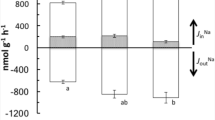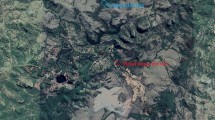Abstract
Formation water (produce water or oil field brine) from oil and gas production usually has high concentrations of soluble salts and metals. The objective of this study was to examine the effect of formation water from Urucu Reserve, Amazon, on whole-body uptake and internal distribution of newly accumulated Na+ in juvenile tamoatá, Hoplosternum litoralle. Groups of fish were submitted to nine treatments for 3 h in 400-ml chambers: control (well water), 5% formation water, and well water with respective concentrations of 5% formation water of Ca2+, Fe, Mn, Ba2+, Fe + Ca2+, Mn + Ca2+, and Ba + Ca2+ added. Specimens of tamoatá exposed to 5% formation water presented a very high Na+ influx, probably due to the high Na+ levels in this water. Waterborne Fe and Mn stimulated Na+ influx, but Fe increased Na+ efflux, causing Na+ loss. Waterborne Mn, on the other hand, decreased Na+ efflux, reducing Na+ loss by this species. Waterborne Ca2+ also affected Na+ influx but had no significant effect on net Na+ fluxes. These results demonstrated that spilling of formation water in ion-poor Amazon rivers would dramatically disrupt osmoregulatory balance of tamoatá and probably other Amazon fish species, impairing their survival and reduce biodiversity.



Similar content being viewed by others

References
Baldisserotto B, Copatti CE, Gomes LC, Chagas EC, Brinn RP, Roubach R (2008) Net ion fluxes in the facultative air-breather Hoplosternum littorale (tamoata) and the obligate air-breather Arapaima gigas (pirarucu) exposed to different Amazonian waters. Fish Physiol Biochem 34:405–412
Bury NR, Grosell M (2003) Waterborne iron acquisition by a freshwater teleost fish, zebrafish Danio rerio. J Exp Biol 206:3529–3535
Caliani I, Porcelloni S, Mori G, Frenzilli G, Ferraro M, Marsili L, Casini S, Fossi MC (2009) Genotoxic effects of produced waters in mosquito fish (Gambusia affinis). Ecotoxicology 18:75–80
Casini S, Marsili L, Fossi MC, Mori G, Bucalossi D, Porcelloni S, Caliani I, Stefanini G, Ferraro M, di Catenaja CA (2006) Use of biomarkers to investigate toxicological effects of produced water treated with conventional and innovative methods. Mar Environ Res 62:S347–S351
CONAMA (Conselho Nacional do Meio Ambiente) (2005) Resolução CONAMA no 357, from March 17, 2005. Diário Oficial União 53(1):58–63
Cooper CA, Shayeghi M, Techau ME, Capdevila DM, MacKenzie S, Durrant C, Bury NR (2007) Analysis of the rainbow trout solute carrier 11 family reveals iron import ≤pH 7.4 and a functional isoform lacking transmembrane domains 11 and 12. FEBS Lett 581:2599–2604
Fish JT (2009) Groundwater water treatment for iron and manganese reduction and fish rearing studies applied to the design of the Ruth Burnett Sport Fish Hatchery, Fairbanks, Alaska. Aquat Eng 41:97–108
Gonzalez RJ, Preest MR (1999) Ionoregulatory specializations for exceptional tolerance of ion-poor acidic waters in the neon tetra (Paracheirodon innesi). Physiol Biochem Zool 72:156–163
Gonzalez RJ, Wilson RW (2001) Patterns of ion regulation in acidophilic fish native to the ion-poor, acidic Rio Negro. J Fish Biol 58:1680–1690
Gonzalez RJ, Wood CM, Wilson RW, Patrick ML, Bergman HL, Narahara A, Val AL (1998) Effects of water pH and calcium concentration on ion balance in fish of the Rio Negro, Amazon. Physiol Zool 71:15–22
Gonzalez RJ, Wilson RW, Wood CM, Patrick ML, Val AL (2002) Diverse strategies for ion regulation in fish collected from the ion-poor, acidic Rio Negro. Physiol Biochem Zool 75:37–47
Graham J (1997) Air-breathing fishes: evolution, diversity, and adaptation. Academic Press, London
Grippo RS, Dunson WA (1996) The body ion loss biomarker. 1. Interactions between trace metals and low pH in reconstituted coal mine-polluted water. Environ Toxicol Chem 15:1955–1963
Grosell MH, Hogstrand C, Wood CM (1997) Cu uptake and turnover in both Cu-acclimated and non-acclimated rainbow trout (Oncorhynchus mykiss). Aquat Toxicol 38:257–276
Hoffmann EK, Hoffmann E, Lang F, Zadunaisky JA (2002) Control of Cl–transport in the operculum epithelium of Fundulus heteroclitus: long- and short-term salinity adaptation. Biochim Biophys Acta-Biomemb 1566:129–139
Hogstrand C, Wilson RW, Polgar D, Wood CM (1994) Effects of zinc on the kinetics of branchial uptake in freshwater rainbow trout during adaptation to waterborne zinc. J Exp Biol 186:55–73
Holdway DA (2002) The acute and chronic effects of wastes associated with offshore oil and gas production on temperate and tropical marine ecological processes. Mar Pollut Bull 44:185–203
Holth TF, Nourizadeh-Lillabadi R, Blaesbjerg M, Grung M, Holbech H, Petersen GI, Alestrom P, Hylland K (2008) Differential gene expression and biomarkers in zebrafish (Danio rerio) following exposure to produced water components. Aquat Toxicol 90:277–291
Hunn JB (1985) Role of calcium in gill function in freshwater fishes. Comp Biochem Physiol A 82:543–547
Jackson RE, Reddy KJ (2007) Trace element chemistry of coal bed natural gas produced water in the Powder River Basin, Wyoming. Environ Sci Technol 41:5953–5959
Lie KK, Meier S, Olsvik PA (2009) Effects of environmental relevant doses of pollutants from offshore oil production on Atlantic cod (Gadus morhua). Comp Biochem Physiol C 150:141–149
Maco Garcia JT (1997) Influência da água de formação da extração de petróleo do Rio Urucu sobre aspectos hematológicos e conteúdo iônico de Colossoma macropomum e Glyptoperichthys joselimaianus. MSc thesis, Instituto Nacional de Pesquisa da Amazônia/Universidade do Amazonas, Manaus
Manfra L, Moltedo G, Lamberti CV, Maggi C, Finoia MG, Giuliani S, Onorati F, Gabellini M, Di Mento R, Cicero AM (2007) Metal content and toxicity of produced formation water (PFW): study of the possible effects of the discharge on marine environment. Arch Environ Contam Toxicol 53:183–190
McDonald DG, Tang Y, Boutilier RG (1989) Acid and ion transfer across the gills of fish: mechanisms and regulation. Can J Zool 67:3046–3054
Nevo Y, Nelson N (2006) The NRAMP family of metal-ion transporters. Biochim Biophys Acta-Mol Cell Res 1763:609–620
Pantaleão SD, Alcantara AV, Alves JDH, Spano MA (2006) The piscine micronucleus test to assess the impact of pollution on the Japaratuba River in Brazil. Environ Mol Mutagen 47:219–224
Petróbras (2008) Provincia petrolífera de Urucu. O desafio de produzir ouro negro na Amazônia. http://www2.petrobras.com.br/minisite/urucu/urucu.html. Accessed 28 Jan 2010
Prodocimo V, Galvez F, Freire CA, Wood CM (2007) Unidirectional Na+ and Ca2+ fluxes in two euryhaline teleost fishes, Fundulus heteroclitus and Oncorhynchus mykiss, acutely submitted to a progressive salinity increase. J Comp Physiol B 177:519–528
Rafii B, Coutinho C, Otulakowski G, O’Brodovich H (2000) Oxygen induction of epithelial Na+ transport requires heme proteins. Am J Physiol C 278:L399–L406
Reader JP, Morris R (1988) Effects of aluminum and pH on calcium fluxes, and effects of cadmium and manganese on calcium and sodium fluxes in brown trout (Salmo trutta L.). Comp Biochem Physiol C 91:449–457
Stephens SM, Frankling SC, Stagg RM, Brown JA (2000) Sub-lethal effects of exposure of juvenile turbot to oil produced water. Mar Pollut Bull 40:928–937
Sundt RC, Baussant T, Beyer J (2009) Uptake and tissue distribution of C4–C7 alkylphenols in Atlantic cod (Gadus morhua): relevance for biomonitoring of produced water discharges from oil production. Mar Pollut Bull 58:72–79
Val AL, Almeida-Val VMF (1995) Fishes of the Amazon and their environments. Physiological and biochemical features. Springer-Verlag, Heidelberg
Wood CM (1992) Flux measurements as indices of H+ and metal effects on freshwater fish. Aquat Toxicol 22:239–264
Woodall DW, Rabalais NN, Gambrell RP, DeLaune RD (2003) Comparing methods and sediment contaminant indicators for determining produced water fate in a Louisiana estuary. Mar Pollut Bull 46:731–740
Zhu SQ, King SC, Haasch ML (2008) Biomarker induction in tropical fish species on the Northwest Shelf of Australia by produced formation water. Mar Environ Res 65:315–324
Acknowledgments
The authors thank National Research Council of Brazil (CNPq; Conselho Nacional de Desenvolvimento Científico e Tecnológico) for fellowships to B. Baldisserotto, L.O. Garcia, L.C. Gomes, and A.L. Val and Rio Grande do Sul State Research Foundation (FAPERGS; Fundação de Amparo à Pesquisa no Rio Grande do Sul) for financial support to B. Baldisserotto. In addition, this work was funded by CNPq and Amazonas State Research Foundation (FAPEAM; Fundação de Amparo à Pesquisa do Estado do Amazonas)–INCT ADAPTA.
Author information
Authors and Affiliations
Corresponding author
Rights and permissions
About this article
Cite this article
Baldisserotto, B., Garcia, L.O., Benaduce, A.P. et al. Sodium Fluxes in Tamoatá, Hoplosternum litoralle, Exposed to Formation Water from Urucu Reserve (Amazon, Brazil). Arch Environ Contam Toxicol 62, 78–84 (2012). https://doi.org/10.1007/s00244-011-9673-z
Received:
Accepted:
Published:
Issue Date:
DOI: https://doi.org/10.1007/s00244-011-9673-z



